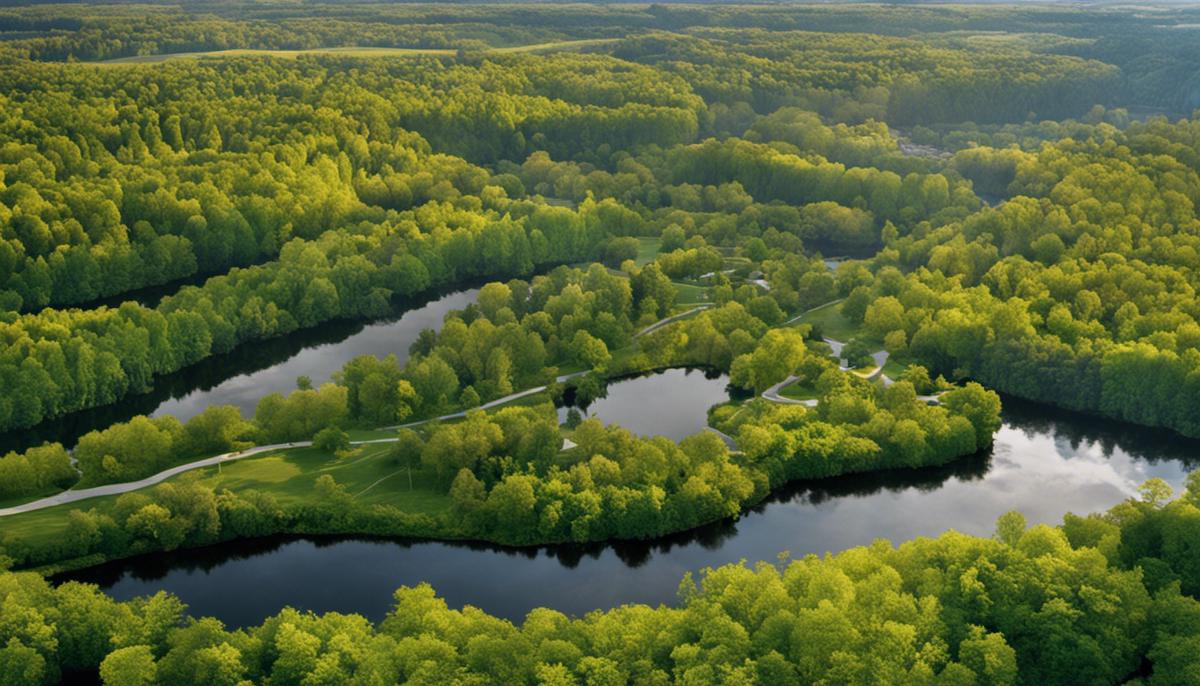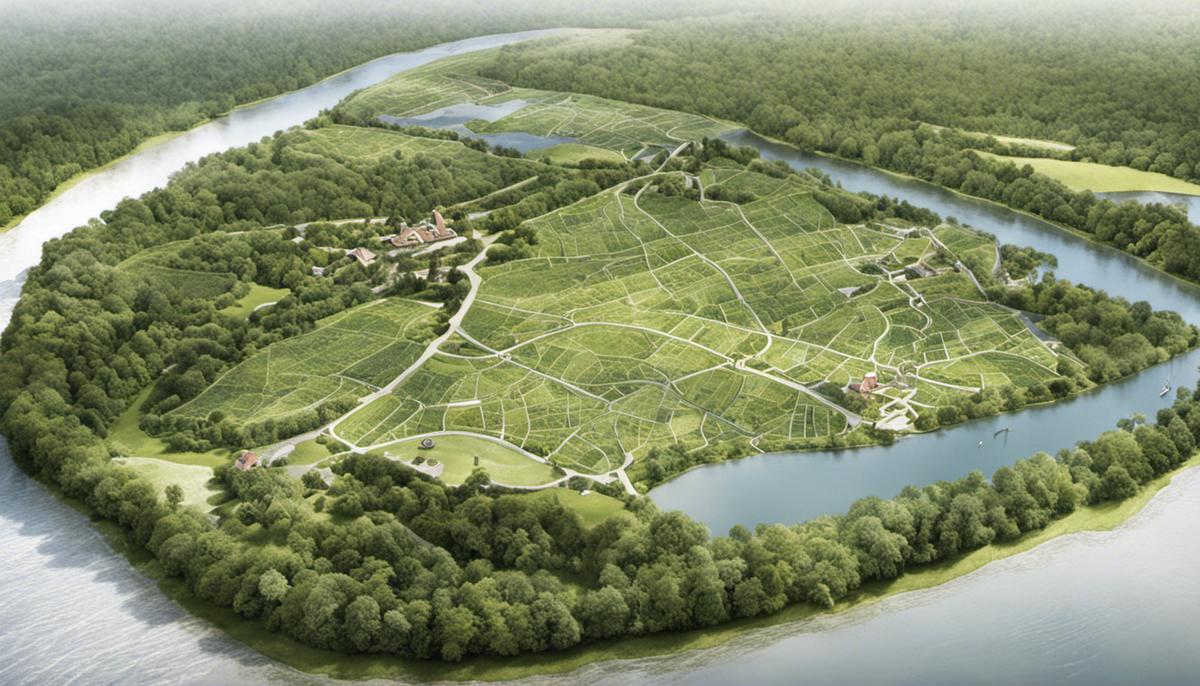Ontario’s Greenbelt, a world-renowned and significant ecological expanse, stands as testament to one of Canada’s most ambitious conservation efforts. Recognizing the importance of this natural beauty in the face of human activities, this exploration embarks upon an interesting journey into its historical establishment, ecological significance, and socio-economic implications. Delving into primary legislation that paved the way for its existence, the vital public figures that championed for its creation, and the initial vision that birthed this initiative, each forms an intricate part of the Greenbelt’s story. Beyond being just a picturesque landscape, Ontario’s Greenbelt’s pivotal role in climate regulation and biodiversity conservation will be unraveled. The socio-economic impact on the surrounding regions, citizens, and the general economy will also be probed as we appraise the past, examine the present, and envision its future.
Origins and Establishment of the Greenbelt
Establishment of Ontario’s Greenbelt: Strategic Steps and Provenance
Ontario’s Greenbelt, a vast area of protected green space, farmland, communities, and marshy wetland encircling the Greater Golden Horseshoe (GGH) area, stands as a stellar example of successful environmental policies and strategic planning. To understand the evolution and establishment of this ample zone, it plays a pivotal role to return to its origins.
In the early 2000s, Ontario grappled with pervasive development pressures. Unregulated urban sprawl and rampant land speculation were weighing heavily on the province’s fertile agriculture lands, and imperiling biodiversity. A clear need for a robust strategy for preserving green space, and protecting agricultural and viticultural lands was felt. The province was in dire need to harmonize burgeoning urban landscapes with the natural environment.
Reacting to this burgeoning crisis, the Ontario government launched the Greenbelt Plan in 2005. It served as an integral part of the provincial government’s coordinated strategy to manage growth, with a significant area of 1.8 million acres established as the permanent Greenbelt.
Strategically, several key steps were taken to ensure the effective execution of this initiative. The methodology adopted by the provincial government was anything but haphazard. Initially, an efficient framework which included clear objectives and goals was established. It was coupled with legislations such as the Greenbelt Act, 2005, which gave legal support to the government’s goals.
Subsequently, scientific studies were conducted to identify and assess key areas to be included. This evidence-based approach facilitated the selection of natural heritage and water resource systems, agriculture lands, environmentally sensitive areas and lands afflicted by urban pressures. A initially proposed area named ‘Whitebelt’ was also considered but later eschewed to consolidate the focus on lands more imperative for preservation.
After the land was identified, the Greenbelt Plan was released to the public for consultations. This scholarly approach ensured a transparent decision-making process and enabled the consideration of diverse viewpoints, including those of the citizens, stakeholders, and other levels of government.
The final and perhaps most crucial step was to establish permanence to ensure that the protected status of the Greenbelt was not subjected to intermittent changes. Once legally established, the Greenbelt became a permanent fixture through stringent provincial Land Use Policies and municipal official plans that were enforceable by law.
The creation of the Ontario Greenbelt was not just the product of strategic steps executed by the government and scientific community. It was a collective endeavor, shaped by political will, public support, legal fortitude, and most importantly, a communal recognition of the crucial need to balance human aspirations with the welfare of the planet.
Today, territories encompassing the current municipalities including Niagara Region, Hamilton, Peel Region, York Region, Durham Region, Toronto, and several others form part of the vast greenbelt. Ontario’s Greenbelt prides itself as the planet’s largest intact greenbelt, testament to the potent combination of meticulous planning, cohesive execution, and the urgent need for an environment-friendly urban lifestyle. However, the battle against urban encroachment continues, a constant reminder for humanity to hold preservation of the environment at the heart of tomorrow’s urban growth strategies.

Ecological Significance of the Greenbelt
Within the geographical confines of the Ontario Greenbelt exists an intricate and highly complex ecosystem that significantly impacts both regional and global biodiversity. Encompassing a vibrant constellation of forests, wetlands, river valleys, and farmlands, the Greenbelt represents a critical ecological buffer, conferring essential services to the regional community and globally recognized species; hence, elucidating its multifaceted role in our contemporary ecosystem is indispensably significant.
One of the most salient functions of the Greenbelt is the provision of substantial ecosystem services, including climate regulation, water purification, flood control, and the preservation of soil quality. Acting as an expansive carbon sink, the woodlands and wetlands within the Greenbelt absorb and store a substantial amount of carbon dioxide, significantly reducing greenhouse gas levels in the atmosphere and contributing to the global mitigation of climate change. Additionally, the Greenbelt’s wetlands operate as natural filtration systems, eliminating harmful contaminants from the water, ensuring the quality and safety of local water supplies. Similarly, these wetlands act as a natural flood control system, capturing and slowly releasing surface runoff, reducing flood peaks, and lowering the risks of water damage during heavy precipitation events.
In agricultural terms, the Greenbelt provides a substantial economic impact. It contains part of Canada’s most fertile farmland, locally known as the Holland Marsh. Known for its rich, organic soil, this region is opted for large-scale vegetable production, contributing significantly to the provincial and national food security. The agricultural lands also provide the fundamental resources necessary for pollinator species such as bees, which play a significant role in food production by enhancing the pollination of crops in surrounding regions.
Furthermore, the Greenbelt underpins biodiversity on a considerable scale, providing habitat for a wide variety of flora and fauna. Significantly, it harbors endangered species and facilitates wildlife movement by providing connected corridors, consequently reducing the effects of habitat fragmentation. This biodiversity contributes to ecosystem resilience, imbuing the region with the capacity to recover from environmental pressures such as climate change and invasive species.
To appreciate the Greenbelt’s inferential contributions to the global ecosystem, it is crucial to cast our gaze towards its role in migratory bird pathways. Serving as a significant stopover habitat, the forests and wetlands of the Greenbelt provide crucial support for bird species during their long, grueling journeys across the globe. These migratory patterns interconnect ecosystems across continents, making the Greenbelt an important link in a global network.
In essence, the Ontario Greenbelt is a beacon of sustainability — representing a model that underscores the symbiotic relationship between human and natural environments. As research continues, our understanding of the multifarious benefits provided by the Greenbelt is likely to deepen. Therefore, it is incumbent we continue to study, preserve, and where possible, replicate this exceptional model of ecological prudence.

Socio-Economic Impact of the Greenbelt
Upon considering the vast geographical extent of the Ontario Greenbelt, it is indeed crucial to delve into the socio-economic impact that unfolds from its existence. Ironically, while the Greenbelt itself is a static geographic area, the effects it produces ripple throughout the economy, and society is notably dynamic.
In socio-economic context, the Ontario Greenbelt serves as a significant contributor to the provincial and national economy. The Greenbelt contributes an estimated $9.1 billion in economic benefits each year, as per a report by the Greenbelt Foundation and David Suzuki Foundation. This includes an impressive $5.4 billion from direct revenue generated from farm sales, tourism, and recreational activities. Thus, the Greenbelt induces an undeniable synergistic effect on diverse economic sectors.
Ontario’s greenbelt, with its fertile agricultural land, proves itself as an economic powerhouse. Besides the lucrative fruit and vegetable sector, its viticultural areas in Niagara and Prince Edward County fuel the burgeoning Ontario wine industry that contributes to local tourism and setting global benchmarks. The engagement of local communities in agri-based vocations not only supports livelihoods but also sustains the innate rural charm, rendering the region desirable for city-dwellers seeking bucolic getaways, thereby maintaining a dichotomy of urban-rural interdependence.
Moreover, the Greenbelt’s well-managed eco-systems also augment a range of essential public health benefits. Ample green, open spaces allow for recreational activities such as hiking, cycling, and camping, all of which invariably improves citizens’ mental and physical health. In the long run, these attributes reaffirm its role as a cornerstone for a healthier populace, inadvertently reducing the economic load on health care systems.
However, the socio-economic implications of the Ontario Greenbelt beat not just at the local level, but it reverberates the national pulse as well. As a model of ecological preservation and intelligent land use, the Greenbelt stands as an emblematic precedent for other provinces, showcasing how to balance economic progression with sustainability effectively.
On the international front, the Greenbelt Plan has set a global benchmark as an advanced and functional urban growth management plan. It provides tremendous precedent for regions grappling with similar challenges of population growth, urban sprawl, and climate change.
In essence, the Ontario Greenbelt encompasses not just a geographical prominence but also asserts a commanding socio-economic significance within Ontario and Canada. With its potent economic output, public health contributions, and environmental preservation, it stands as a beacon of sustainable planning, serving as a template not just at a national but also at a global level. Therefore, the discourse around its preservation and expansion must account for these articulately interlinked factors. These factors, too, underline why urban growth strategies should not just maintain, but ideally extend this remarkable belt of green.

Current State and Future Prospects of the Greenbelt
The Ontario Greenbelt continues to thrive even amidst various developments. Having considered the past and the present, the natural inclination is to turn an eye towards the future. As it stands, the Greenbelt is not without its challenges. Pressures from industrial and residential development persist, and the necessity for continued vigilance, regulation and creative thinking cannot be overstressed.
The climate crisis is a poignant and present specter which highlights the growing need for spaces like the Greenbelt. Its role as a carbon sink is increasingly vital; it absorbs approximately 1.96 million tonnes annually. This offsets a significant portion of greenhouse gas emissions and hence helps mitigate climate change.
Predicated on this understanding, future management strategies for the Ontario Greenbelt must seek to enhance this carbon sequestration capacity. The advance of the Emerald Ash Borer beetle, for example, has spurred widespread tree mortality, threatening this active carbon sequestration. Climate resilient tree species can replace deceased trees to ensure that the Greenbelt continually operates as an effective carbon sink.
Water management is another factor that future policy must underscore. Ontario’s population is expected to grow to 21.3 million by 2051, placing inordinate demand on fresh water sources. The Greenbelt’s watersheds, wetlands, and marshlands purify water, prevent soil erosion, mitigate floods, and replenish groundwater stores. The role of the Greenbelt in contributing to freshwater availability remains central to future sustainability efforts. An emphasis on preserving hydrological systems and promoting watershed protection thus becomes paramount.
Expanding the Greenbelt is an additional focus area. The current “bluebelt” proposal seeks to protect water sources via the addition of 1.5 million acres of land to the Greenbelt. This strategy recognizes the interconnectedness of environmental systems and seeks to preserve the integrity of the Greenbelt alongside other ecological spaces.
Lastly, the interaction between people and the Greenbelt holds significant promise for the future. Initiatives that foster a sense of ownership and pride are essential. In promoting citizen engagement, programs similar to “Friends of the Greenbelt” could see wider implementation. These community-based events such as tree-planting and clean-ups foster awareness and participation, arguably the best defense for this treasured landscape.
In conclusion, the essence of the future for the Greenbelt lies in its integration – into climate change strategies, water management policies, urban growth models, community programs, and most importantly, into the hearts and minds of the people. As our society continues to navigate the myriad challenges of the 21st Century, the Ontario Greenbelt stands at the forefront as the veritable object of our collective responsibility, striving and vision.

As we gaze upon the natural beauty that is Ontario’s Greenbelt, it’s quintessential to appreciate the profound impacts it makes, both ecologically and socio-economically. The journey through its origins, significance, impact, and its current trajectory elucidates the pivotal need for such conservation efforts. The future prospects of the Greenbelt, interspersed with the challenges and possible expansion plans, urge not just policy-makers and conservationists but every citizen to appreciate, protect, and enhance this green legacy we’ve inherited. It is indeed much more than a nature’s reserve; it’s Ontario’s heart, breathing life and contributing to the economy while acting as a bold counter-narrative against unrestrained urban sprawl. The legacy of Ontario’s Greenbelt is a narrative of successful conservation that needs ongoing nurturing and preservation for generations yet unborn.

Matt Smith is a seasoned journalist and author whose expertise spans across the dynamic realms of Politics, Gadgets, Gaming, and a plethora of general interest topics. With a Master’s in Political science and tech pedigree shaped in Silicon Valley, Matt brings a wealth of knowledge and a critical eye to everything he writes.
Politics: Matt offers sharp political commentary, drawing from his experience as a political analyst and his academic rigor.
Gadgets: His tech insights are grounded in real-world experience, having been on the front lines of innovation with a degree from Caltech.
Gaming: A respected voice in gaming, Matt’s reviews and trend analyses are a testament to his deep involvement in the gaming community.
General Topics: From science to culture, Matt’s writing spans a broad spectrum, engaging readers with a blend of expertise and relatable prose.
Engage with Matt’s compelling content for a fresh perspective on the issues at the forefront of today’s discourse.

